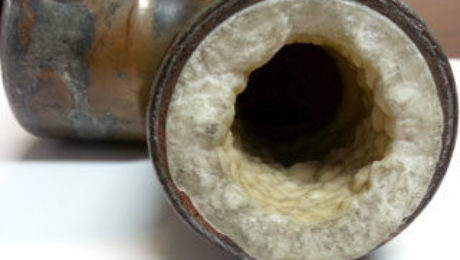Hard Water Fixes? Not Hard at All.
Where the term “hard water” originated is a bit uncertain. Some people say it’s from the minerals “hardening” on the surface, some say because it’s “hard” to clean, and others say it’s because it makes it “hard” to get soap to lather.
Whatever the origin, due to the amount of minerals, hard water has a big impact on day to day life. It can shorten the life span of clothes by up to 40%, dry out skin and hair, damage the functionality of appliances, leave spots of film on dishes, clog pipes, reduce water flow and can increase energy bills by up to 25%.
Don’t worry, it sounds like a daunting list, but with some maintenance, you can keep the damaging effects at bay and it becomes nothing more than a nuisance.
First, let’s talk about the problem. What causes hard water?
Hard water is contains calcium, magnesium and sometimes even iron. It is created when the water absorbs the minerals while passing through soft rock such as limestone. (And Florida’s land contains large amounts of limestone.)
Don’t fret, you have options.
Option 1: Purchase a water softening system.
These systems can eliminate the calcium and magnesium replacing them with a softer mineral like sodium or potassium. Systems will vary in cost depending on the size of your home, but if it’s financially viable, this option could double the life of your appliances.
Option 2: DIY
When it comes to do-it- yourself pipe and plumbing fixture cleaning, you can either use a commercial hydrochloric acid product (**Use with extreme care** Muriatic Acid is a weaker form of Hydrochloric Acid, however extreme care is still highly recommended.) or a natural cleanser of vinegar and baking soda. Both work well, however the commercial products can be expensive, and you don’t want to risk getting it into your potable water. (Also be sure to wear gloves and goggles while working.) The benefit to this method is that it only takes about 10-15 minutes and the instructions are pretty self explanatory. With a natural cleanser, it takes more time but is less expensive and as the name implies, is all natural. We’re going to give you the low-down on the natural method, but as we said, it’s a personal preference.
The Natural “How”
To clean fixtures:
Use one part white vinegar to 3 parts water. Dismantle removable parts and put to soak in vinegar solution. Use a toothbrush or other soft bristle to scrub calcium away. For the main fixtures, soak a soft cloth with the solution, then wipe the fixture to remove any flaking. Rinse cloth, re-soak in vinegar solution, then wrap around the fixture for 15 minutes. The rest of the deposits should clean away easily.
For Pipes:
For a 1,000 sq. foot home, you will need 2-3 gallons white vinegar and 1 cup baking soda per drain.
Fill a large pot of water for each drain. Shut off all taps, including any outdoor faucets. Put 1 coup of baking soda down each drain and slowly pour in the vinegar, (as much as the sink will hold,) it should bubble and fizz. This solution should sit for about 3-4 hours. 30 minutes before the solution is ready to drain, boil the pots of water. When ready, pour down the drains quickly and forcefully, which will dissolve grease and soap and help sanitize. Open the faucets one by one at full blast. You may see calcium and limestone chunks, which is normal. Some of the residue may be powdery and stuck at the bottom of the pipes. It’s a good idea to open the drain pipes and clean out the p-traps.
Just remember, it’s not rocket science, but it is important not to let it go too long or you may end up replacing pipes.
- Published in Tips of the Trade

